The Ultimate Guide to Unrefined and Raw Sugars
- Adriane Campos

- Feb 5
- 10 min read
Updated: Jul 2
While spooning white sugar into your coffee, your kids sprinkle brown sugar on their cereal. And you recognize that familiar pang of guilt. You have been trying to reach for fruits instead of pastries and muffins, but this other important piece of eating healthy feels difficult.
Is it possible to find a "better" sugar you can actually feel good about?
You hear "raw" or "unrefined" sugar and think "healthier." But what do these terms really mean?
Even as a sweetener enthusiast, I get why these terms are confusing. There are so many types of raw and unrefined sugars—yet they all come from the same plant: sugar cane. So, instead of walking up and down grocery store aisles, confused by shelves full of options, let me take the guesswork away. I've sorted cane sugars into three categories, and I'm here to give you a digestible guide. One spoonful at a time.

1. You Should Know This
The term "cane sugar" means any sweetener derived, directly or indirectly, from sugarcane — whether dry (granulated, powdered, cubes) or liquid (like syrups and molasses).
Because sugarcane can be processed into nearly forty types of sugar, I created the chart below to help you compare them at a glance.
Cane sweeteners come out of two facilities:
Sugar mills are located close to cane plantations and produce what’s known as "unrefined" and "raw" sugars, which come straight from the freshly harvested cane.
Sugar refineries, on the other hand, produce the most widely available sweeteners in stores – such as granulated, brown, and confectioners sugar. These don't come directly from the sugarcane plant. Instead, refineries use what is called a "crude raw sugar" (more on that later) as starting material.
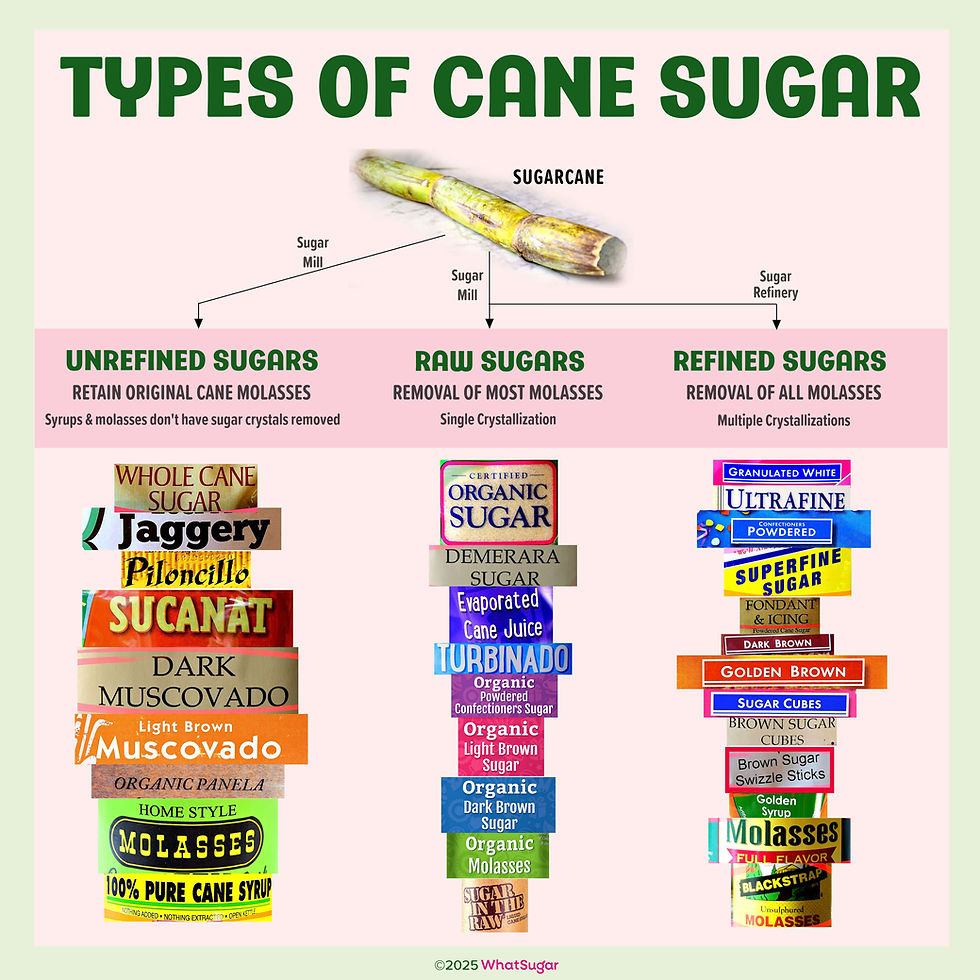
If you're thinking: Is unrefined sugar better than refined sugar? What are the benefits of unrefined sugars? What is the difference between turbinado, demerara, and muscovado sugars?
Hold that thought for a moment.
2. What Is Unrefined Sugar?
All cane sugars go through steps to remove impurities (= refining process). The so-called unrefined sweeteners are the least refined, as they retain most of the original cane molasses.
It includes traditional brown sugars – muscovado, panela, jaggery, and piloncillo – and those produced by a more sophisticated drying method, such as Sucanat.
How is it made?
Unrefined sugars come straight from the freshly harvested cane and are then refined as follows:
Three steps: Put simply, the production process starts by collecting and clarifying the cane juice, which is then concentrated. As the juice's water boils off, a sticky dark syrup, called molasses, surrounds the pure sucrose crystals.
No centrifugation: They retain the molasses around the sucrose crystals and, typically, are not centrifuged. A centrifuge [picture a salad spinner] separates sugar crystals from the molasses. Raw and refined sugars have most or all of the original cane molasses washed off by centrifuging their crystals, but unrefined sugars don't.
Most unrefined sweeteners are "traditional artisan sugars," produced in small batches, with little capital, in sugar mills around the world in sugarcane-growing regions using hundreds of years of know-how.
Some unrefined sugars come from organic sugarcane. If processed, handled, and packaged according to the USDA organic standards, they might carry the certified organic seal. I wrote a post about organic sugars here.
What's in it?
With 8 to 14% molasses, unrefined sugars' crystals hold a strong flavor and dark brown color. The sugar content runs around 90% sucrose and 5% invert sugar (glucose plus fructose).
How to recognize it in stores?
Depending on where they come from, traditional brown sugars have different names: muscovado (Mauritius, Phillippines), piloncillo (Mexico), jaggery (India), panela (Colombia), kokuto (Japan), rapadura (Brazil), and rock sugar (China).
Sucanat (a registered trademark which stands for Sugar Cane Natural) and other similar products labeled as "whole cane sugar" are unrefined sugars produced by a patented drying process, which results in a sweetener that does not clump, cake, or harden.
To check if a syrup or molasses is unrefined, look for terms such as traditional, home-style, open kettle, or original.
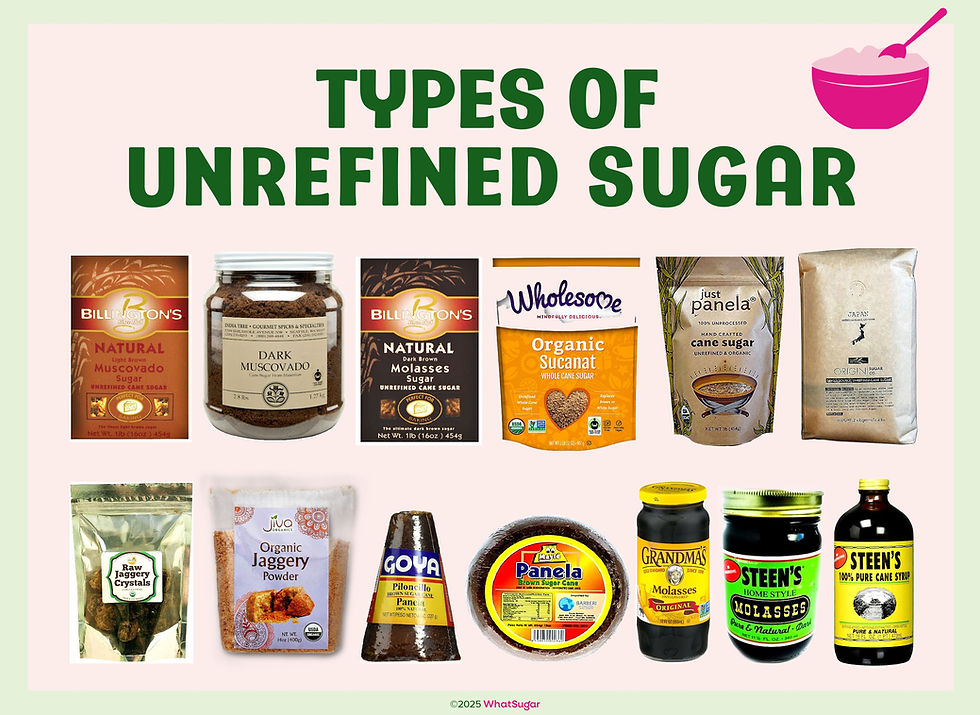
I invite you to explore my Unrefined Sugars page to see all the sweeteners I've found in stores. For a deeper dive, check out this blog post: Unrefined Sugar: 4 Myths and How it Compares with Common Sweeteners

🇧🇷 Born and raised in Brazil, I grew up with “melado,” “mascavo,” and “rapadura” on the table. After years of analyzing sugars sold in the U.S., I’m launching a line of certified organic cane sugars in 2025 that honor those roots. WhatSugar™ | The Sweetener Co. brings you unrefined sugar from Brazil, handpicked for quality you can trust. Email us info@whatsugar.com to stay in the loop.
3. What Is Raw Sugar?
Raw sugar doesn't mean an unrefined, unprocessed, or "in its natural state" sweetener. Instead, it means a single crystallization sugar (it is crystallized only once). After sugar crystals form, the original cane molasses is washed off almost entirely.
How is it made?
Raw sugars come straight from the freshly harvested cane and are highly refined.
Raw sugars are produced directly from the cane juice in a sugar mill close to cane fields. After the juice is extracted and clarified, it undergoes a single-crystallization process. Crystals are then centrifuged to remove most of the cane molasses.
Most organic sugars we see in stores are raw sugars made from organically grown sugarcane and processed, handled, and packaged according to the USDA organic standards. More on organic sugar HERE.
What's in it?
Raw cane sugars usually have less than 2% molasses, which gives them a delicate flavor and a color ranging from blond to light brown. They are slightly less refined but more processed than the unrefined sweeteners listed first in this post, as they generally contain 97 to 99% sucrose.
How to recognize it in stores?
Raw sugars are also called turbinado, demerara, evaporated cane juice, dried cane syrup, dehydrated cane juice, less processed cane sugar, washed sugar, natural cane sugar, and single-crystallization sugar. I made a video showcasing the names of dozens of raw sugars HERE.
Their crystals size varies from medium to coarse. Coarse crystals are sparkly, light to medium brown in color. Medium-size crystals (slightly larger than table sugar) are blonde to pale brown.
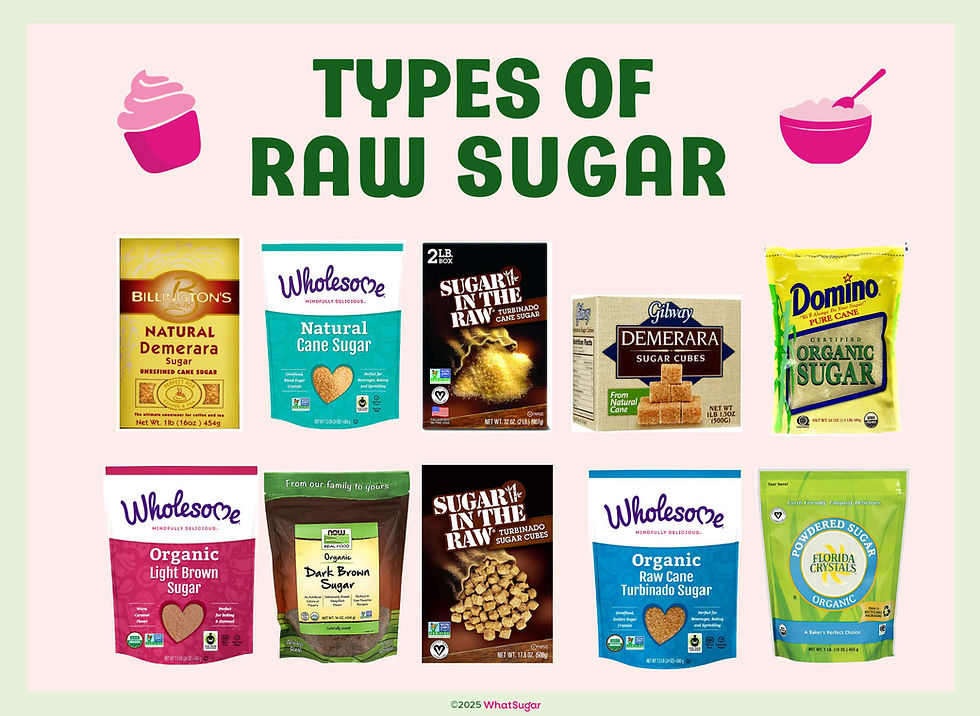
Visit my Raw Sugars page to explore all the sweeteners I've found in stores. Or, to learn more, dive into Raw Sugar: From Turbinado to Demerara, Find out Exactly What it is.
4. What Is Refined Sugar?
When we think of refined sugar, white granulated sugar usually comes to mind – and I wrote all about it HERE. But there are more than twenty other types of refined cane sugar you’ll find in stores.
How is it made?
Refined sugars are highly processed and purified sweeteners produced from crude raw sugars.
As opposed to the sweeteners listed before, refined sugars are not produced directly from the cane juice. Instead, they are obtained from crude raw sugar, which is not the same raw sugar explained above. Both raw sugars come out of sugar mills, but the crude version contains a high level of impurities and is sold only to refineries. A refinery is often located close to a waterway to receive raw sugar transported by ship from sugar mills around the world.
The production process involves the removal of raw sugar impurities by remelting, filtering, evaporation, and centrifuging.
Raw and refined sugars have the same basic process: concentration, crystallization, and centrifuging. The difference is that only a single cycle produces raw sugars. On the other hand, refined sugars are purified through a series of cycles.
I am often asked, "Is there an organic white sugar"? The answer is no. Due to the use of synthetic chemicals to help remove impurities, refined sugars made in the United States cannot be certified organic.
What's in it?
The main component in any refined sugar is sucrose—from 91 to 99.96% when in solid form, and from 50 to 80% when liquid (syrup, molasses). Considered one of the purest food products, granulated white sugar (aka table sugar) is 99.95% sucrose.
How to recognize it in stores?
I found fifteen dry refined sugars in several crystal sizes, molasses, and water content. Get the details on my refined sugar page. For details on liquid sweeteners, visit THIS page.
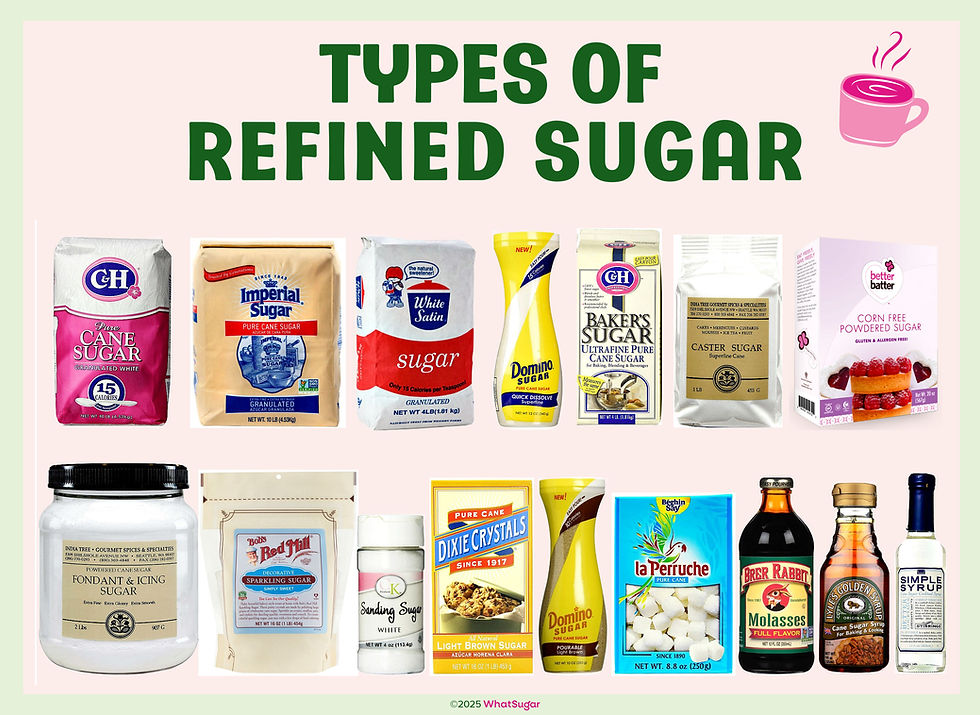
1. Based on the size of the crystals, white sugars are labeled as granulated, fine granulated, extra fine granulated, superfine (quick dissolve), ultrafine (baker’s special, baker’s sugar, caster sugar), powdered (confectioners), and fondant (icing or frosting sugar).

2. Based on their amount of molasses, brown sugars are labeled as light (golden) and dark. “Pourable” brown sugar (Brownulated) is a refined brown sugar that does not clump, cake, or harden.
3. Coarse refined sugars include sparkling sugar, rock sugars, and sugar swizzle sticks.

4. Refined sugars in lump form are made from table sugar and brown sugar, which are first moist with water, then compressed or molded into a particular shape, and allowed to dry. They include white and brown sugar cubes, tablets, and gourmet sugars.

5. Liquid refined cane sugars include simple syrups, invert syrups, and light, dark, and blackstrap molasses.
To learn more, read another blog post: Here's a Quick Way to Learn About 20+ of the Favorite Refined Sugars
5. What Is the Healthiest Cane Sugar?
We covered the fact that cane sugars are an excellent source of calories—mostly from sucrose. However, they are not a significant source of any other nutrient. One exception is cane molasses, which is a good source of minerals, but we don't eat enough of it to get the health benefits.
A common misconception is that raw and unrefined sugars are healthier than table sugar...
Those no-guilt-inducing types of sweeteners.
Unrefined sweeteners do have slightly more nutrients, such as vitamins, minerals, and antioxidants when compared to refined and raw sugars.
However, the amount per serving is minuscule. We would have to eat a truly unhealthful amount of unrefined sweeteners (100 g or even a cup) to get a daily micronutrient requirement or the positive health effects from them.
The calories and sugar content in unrefined sugar outweigh the advantages of antioxidants, vitamins, and minerals.
Here are the surprising truth about cane sugars:
• Any sweetener from cane is a blend of sugars (simple carbohydrates) and water.
Their main component is sucrose, a double sugar. Their second predominant components are glucose and fructose, both simple sugars. Their water content varies from 0.03 percent (in most white granulated products) to 50 percent (in syrups and molasses).
Dry sweeteners contain over 95 percent sugar and provide about 15 calories per teaspoon. Sweeteners in liquid forms have over 50 percent sugar and provide approximately 20 calories per teaspoon.
• All cane sugars are easily digestible and quickly absorbed into the bloodstream.
The glycemic index (GI) of refined, raw, and unrefined cane sugars are not much different. It varies from about 60 to 68:
GI refined white sugars (powdered, ultrafine, superfine, caster): 64±4
GI brown sugars (unrefined, raw, refined): 62±2
GI raw sugars (organic white and brown, turbinado, demerara): 62±2
GI syrups (golden syrup, simple syrup, cane syrup, liquid raw sugar): 62±3
GI molasses (mild, dark, blackstrap, traditional): 62±1
If you're looking for the healthiest sugar with the lowest glycemic index? Read THIS.
6. The 3 Real Reasons to Choose Unrefined and Raw Sugars
We now know unrefined and raw sugars are not better for our health than refined sugars —they're not much different in terms of nutritional value.
But if you’re thinking, Is unrefined sugar better for baking? Is raw sugar better than white sugar for my coffee? The answer is yes.
The real reasons to choose unrefined and raw sugars include:
• They offer a unique taste and aroma
Unrefined and raw sugars have the same sweetness as table sugar, but they offer a more complex flavor.
Raw sugars, such as turbinado, demerara, and organic cane sugar, have a delicate molasses taste and aroma. They are perfect to add a hint of flavor to coffee, tea, cappuccino, latte, and cocktails. Sprinkle over cereals and fruits. Blend with cinnamon and sprinkle over waffles, French toast, or pancakes.
On the other hand, unrefined sugars provide a more robust lingering molasses flavor. They pair well with ginger, coffee, chocolate, vanilla, butterscotch, and cinnamon.
• They give a boost to beverages, cooking, and baking goods
Simply replacing one tablespoon up to a quarter of the table sugar with unrefined sugars will result in richer baking goods [more than that amount, it starts to affect the way they rise].
Unrefined sugars add depth to baked goods—brownie, banana bread, chocolate chip cookies—rib rubs, barbecue sauces, beef stews, and hot chili. Try it over your hot cereals, French toast, ice cream, hot chocolate, granola bars, and cinnamon rolls. Cookies will be less crisp but chewier whenever we remove a dryer sweetener and substitute it with another with higher moisture and stickier, such as muscovado sugars.
Raw sugars have an attractive sparkly crystal, and those labeled as demerara have coarse crystals. Because they hold their shape when heated, use them as a finishing sugar to add a crunchy topping to cookies and muffins.
• They are a one-to-one substitute for refined sugars
Unrefined sugars are perfect 1:1 substitutes in any recipe calling for regular refined brown sugars.
For the most part, you can directly swap table sugar with unrefined and raw sugars in cookies and some cakes [but not for fine-textured and fancy cakes, puddings, or desserts where smoothness is desired].
To make their crystals smaller, easy to dissolve, and faster to incorporate in recipes, pulse sugars in a food processor or coffee grinder.
Prep unrefined sugars sold in blocks (in panela) and cones (jaggery, piloncillo) before use. Grind and then sift to remove firm clumps.
When baking with light muscovado, dark muscovado, or molasses sugar, you can use an equal amount of firmly packed measure. But, because of their higher moisture, slightly reduce liquid content by one to two tablespoons. No need to reduce wet ingredients when using drier unrefined sugars, such as Sucanat and whole cane sugars. Just note: they do not cream and dissolve the same way as table sugar.
The Bottom Line
All cane sugars are refined to some extent, even the so-called "raw" and "unrefined" — which are only slightly less refined and, in terms of nutritional value, not much different from white sugars. If a less processed sweetener is what you are looking for, then try raw and unrefined sugars.
One cane sugar is not necessarily better than another. Each one works well for some applications and not for others. The benefits of sweeteners such as turbinado, demerara, and muscovado come from their unique taste, aroma, and that no-guilt-feeling they bring to the table.
When you buy through Amazon links, this blog may earn an affiliate commission at no cost to you.
#unrefinedsugar #canesugar #rawsugar #refinedsugar #evaporatedcanejuice #turbinadosugar #driedcanesyrup #demerara #sweetenerreview #refinedversusrawsugar #unrefinedversusrawsugar #refinedversusunrefinedsugar #whiteversusbrownsugar #brownulatedsugar








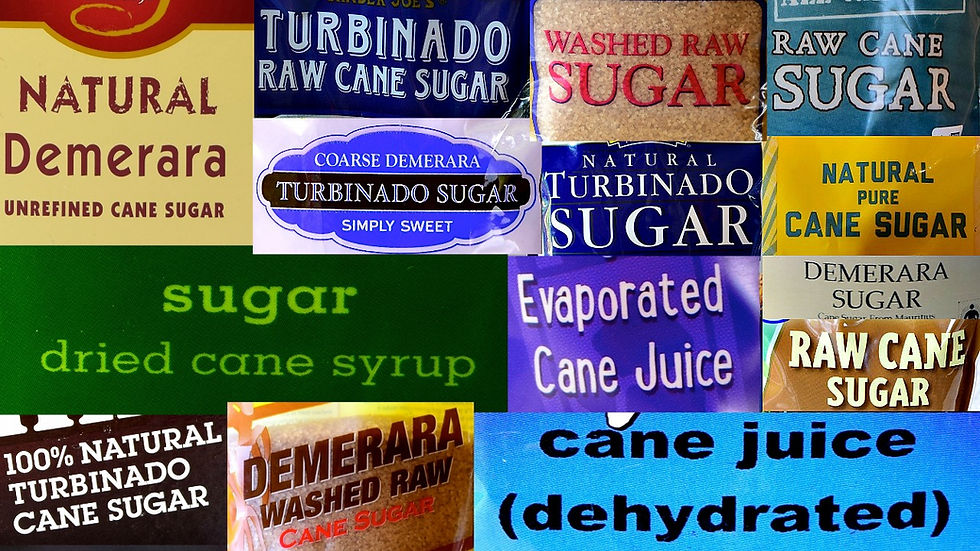
Great information!
ITS NOT FREE.. ad shows free, but them it cost money and your email is full of crap.. NOT THANK YOU
The advantage of eating foods closest to their whole, natural form is that the whole, natural form contains all of the cofactors needed to properly metabilize that food. Sugar, eaten without its naturally occurring vitamins and minerals, will have to steal those required vits & minerals from that person's body stores in order to digest and absorb that sugar. Then, some other process or need in the body is left short-changed those necessary nutrients. For example, B vitamins are required to metabolize sugar. The brain also needs B vitamins to function properly. The adrenal glands require B vitamins to help you deal with stress. So, when somebody eats refined sugar (or other refined carbs), the B vitamins which would normally…
I understand they use animal bone char to process refined sugar. I have Alpha Gal Syndrome and need to know if it is used in unrefined or raw sugars you have listed. Thanks for your time.
Dear Adriane,
I own a sugar cane farm and i'm curious about packaging and selling small amounts of raw sugar as a novelty item right out of the sugar mill. What are the roadblocks to doing this as a profitable venture?